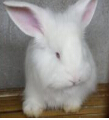夏季養殖長毛兔要注意什么
 發布日期:2023-08-12
來源:http://guijingwen.cn 發布人:admin
發布日期:2023-08-12
來源:http://guijingwen.cn 發布人:admin
1、遮陰防暑
1. Shading and heatstroke prevention
在進入夏季之后我們要提前在合適的時間內熟悉長毛兔的養殖環境。在夏季到來之前,長毛兔也要做好剪毛工作。因為要防止溫度過高,導致長毛兔散熱不均,合理剪毛能夠有效的促進長毛兔散熱降溫。如果發現兔子有出現發熱、眼球突出及抽搐等情況時,便代表長毛兔中暑了。這個時候一定要及時將病兔放在陰涼的地方,然后用敷好濕毛巾,灌冷水加入人丹進行搶救。
After entering summer, we need to familiarize ourselves with the breeding environment of the long haired rabbit at an appropriate time in advance. Before summer arrives, long haired rabbits also need to do a good job of shearing. Because it is necessary to prevent excessive temperature from causing uneven heat dissipation in long haired rabbits, reasonable shearing can effectively promote heat dissipation and cooling in long haired rabbits. If a rabbit is found to have fever, protruding eyeballs, and convulsions, it indicates heat stroke. At this time, it is necessary to promptly place the sick rabbit in a cool and shaded place, and then use a damp towel to apply cold water and add the human pill for rescue.
2、防悶
2. Dehumidification and stuffiness prevention
夏季的降雨量是非常多的,所以空氣的濕度也比較大,高溫高濕的環境是非常不適合長毛兔的生長的。所以在夏季我們要盡量搭好遮蔭棚,然后要做好通風工作。溫度高的時候在籠舍內可放入涼水泡過的磚塊,不過要用袋子裝好,幫助長毛兔降溫。有條件的可以安裝降溫設備,促進散熱降濕。如果地面潮濕的話,那么我們要適當潑灑草木灰等進行中和。遇到暴雨天的時候要注意避雨,積水,防止返潮。
The rainfall in summer is very high, so the humidity of the air is also relatively high. High temperature and humidity environments are very unsuitable for the growth of long haired rabbits. So in summer, we should try to set up a good shade shed and then do a good job of ventilation. When the temperature is high, bricks soaked in cold water can be placed in the cage, but they should be packed in bags to help the rabbit cool down. If conditions permit, cooling equipment can be installed to promote heat dissipation and humidity reduction. If the ground is damp, we need to sprinkle grass and wood ash appropriately to neutralize it. When encountering rainstorm, pay attention to shelter from rain, remove accumulated water and prevent tide returning.

3、飼喂方法
3. Feeding methods
夏季的溫度是比較高的,所以我們要根據夏季的特點合理調整長毛兔的飼料。減少能量等營養比例,提高蛋白質的含量。然后提高青飼等多汁飼料的飼喂量,因為溫度較高,所以夏季長毛兔的進食量是會有所下降的。所以我們要適當提高日糧中的粗蛋白標準。然后飼喂時間要避開中午等高溫時間,在早晚等溫度不高的時候進行。這樣能夠有效的提高進食量,我們還要注意提供充足的飲水,滿足長毛兔生長的營養水分需求。
The temperature in summer is relatively high, so we need to adjust the feed for long haired rabbits reasonably according to the characteristics of summer. Reduce the proportion of energy and other nutrients to increase protein content. Then increase the feeding amount of juicy feed such as green feed, as the temperature is higher, so the consumption of summer long haired rabbits will decrease. So we need to appropriately increase the crude protein standard in the diet. Then, the feeding time should avoid high temperatures such as noon, and be carried out in the morning and evening when the temperature is not high. This can effectively increase food intake, and finally, we also need to pay attention to providing sufficient drinking water to meet the nutritional and water requirements for the growth of long haired rabbits.
長毛兔
Long haired rabbit
長毛兔
Long haired rabbit
4、注意事項
4. Precautions
進入夏季之后我們要適當降低密度,有條件的更好是一只一籠,更多每個兔籠也不能夠超過3只。夏季公兔的精液質量是會受到很大影響的,母兔配種的話容易出現流產、泌乳不足等各種不良現象。所以在夏季我們要暫停配種工作,保證種兔正常生長,在秋季等溫度適宜的時候再進行。再做好環境的衛生工作,加強蚊蠅鼠害防治工作。就是疾病的防治了,夏季常見的有兔瘟、兔巴氏桿菌病等,都是需要我們著重注意的。
After entering summer, we need to reduce the density appropriately. If possible, it is best to have one rabbit per cage, and the maximum number of rabbits per cage should not exceed 3. The semen quality of male rabbits in summer can be greatly affected, and female rabbits are prone to various adverse phenomena such as miscarriage and insufficient lactation during mating. So in the summer, we need to suspend breeding work to ensure the normal growth of breeding rabbits, and then proceed in autumn when the temperature is suitable. Further improve environmental hygiene and strengthen the prevention and control of mosquito, fly, and mouse pests. Finally, there is the prevention and treatment of diseases. Common diseases in summer include rabbit plague, rabbit pasteurellosis, etc., which require our special attention.



 發布日期:2023-08-12
來源:http://guijingwen.cn 發布人:admin
發布日期:2023-08-12
來源:http://guijingwen.cn 發布人:admin